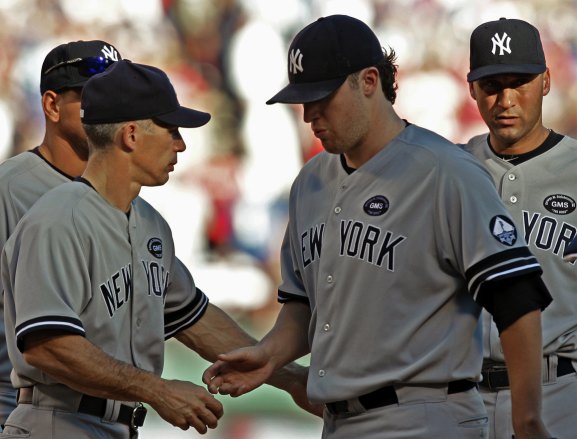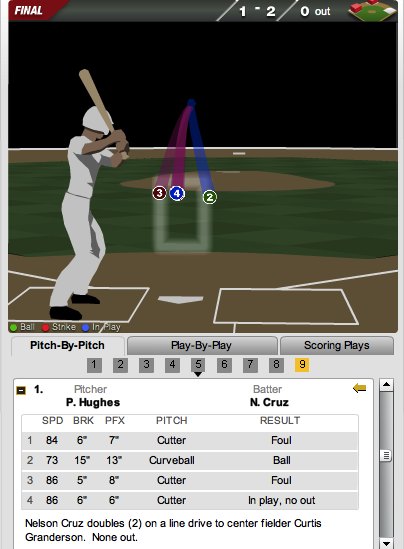
In his first two playoff starts Phil Hughes has realized markedly different results. Against Minnesota he shined, throwing seven innings of shutout ball. That left the team with high hopes for his Game 2 start against Texas, but it didn’t go as expected. It started small, with a cheapie run in the first, but it ballooned to seven earned runs before he recorded an out in the fifth. The Yankees cannot afford a repeat performance tonight.
If you take a look at Hughes’s pitch breakdowns from the Twins game and then the Rangers game, you might notice something obvious. When he dominated against Minnesota he threw just seven cutters. Against Texas not only did he throw over three times that many, he also saw disastrous results. Just look at the Linear Weights column. The Rangers absolutely murdered his cutter, twice as badly as they did his four-seamer. That suggest Hughes should cut down on his cutter usage, right?
PitchFX is great. It provides us with information that previously only teams had. Even then, teams had to watch every pitch, classify it, and plot it. There is certainly potential for error there. PitchFX leaves everything up to high-speed cameras, so there is a greater degree of precision. But it is still prone to error, especially when it comes to pitch classification. As it turns out, Hughes didn’t throw a ton of cutters. It’s his four-seamer that got destroyed.
When I first sat down to write this I planned to center it on the cutter usage between the two games, because it seems like an obviously important factor in tonight’s game. If Texas is killing his cutter, Hughes has no choice but to scale back its usage and try to mix it in with more cunning. But after looking at the first two pitches he threw to Elvis Andrus, both classified cutters, it’s clear that PitchFX made a few errors. The first pitch had 10 inches of vertical break and 4 inches of horizontal break; the second had 12 inches of vertical break and 3 inches of horizontal. Those are in line with Hughes’s four-seamer rather than his cutter. Scrolling down to Vladimir Guerrero, we see a cutter with 7 inches of vertical break and 6 inches of horizontal, and at 89 mph. That’s more like his cutter.
By my count Hughes threw just 11 cutters against the Rangers, and only one caused serious damage. That came in the fifth, with Nelson Cruz at the plate. Hughes started him with a cutter up and Cruz fouled it off. Then he missed with a curveball away. The next cutter was also up, but was a bit more inside. Cruz fouled that one off also. On the fourth pitch Hughes delivered a cutter to the exact same spot as the first one. It’s no wonder that Cruz laid into it. Additionally, Cruz had seen one cutter in each of his first two at-bats, and each time he fouled it off. It was only a matter of time.

What appeared to be Texas’s two biggest hits off the cutter — David Murphy’s second-inning home run and Michael Young’s RBI double four batters later — were both fastballs. In fact, they had the same vertical and horizontal breaks, 11 and 4 inches. This fastball futility came as something of a surprise, considering Hughes used it to finish off each of his three first-inning strikeouts. But after that it appeared to lose some effectiveness. In the fourth he was lucky that Vlad hit a fastball right to Nick Swisher. In the fifth Ian Kinsler hit a fastball, the third of the at-bat, for a triple.
Hughes’s lack of fastball success as the game went along was no secret. It played a big role in Frankie Piliere’s breakdown of the game:
The big issue, however, was that Hughes was unable to locate those pitches. On top of that, the fastball command he had against the Twins was also gone. Working at 93-94 mph with his short arm action, he still had more than enough to miss bats early. But, as the game rolled along the Rangers made the adjustment Hughes had to know they’d eventually make. They began to sit on the fastball early in the count as it was more than evident that Hughes had nothing else to offer them.
Another sign of ineffectiveness of the four-seamer and cutter was the rate at which the Rangers fouled off the pitches. Of his 68 four-seamers and cutters the Rangers fouled off 22, 32.4 percent. This is a problem for two reasons. First, Hughes led the AL in percentage of strikes as foul balls, and by no slim margin. Of the 3,003 pitches he threw in the regular season, Hughes got a strike 1,982 times. Of those strikes, 674 were foul balls (34 percent). The next closest pitchers threw 31 percent of their strikes for fouls. Only 10 qualified starters even broke the 30 percent mark.
Second, the Rangers have been fouling off pitches, especially two-strike pitches, at a torrid rate in this series. This requires a thorough explanation, so I will point you to friend of RAB Larry Koestler at Yankeeist, who breaks down the Rangers’ foul ball tendencies, especially when they have two strikes. Try to keep your cool as you look at his chart and see Hughes’s results once he got two strikes on the hitter.
What precedes leads to a fairly obvious conclusion: Hughes cannot rely on his fastball to get through the Rangers lineup. That’s not to say he should put it in his back pocket; it is still his best pitch and he’s going to need it in order to succeed. But he’ll also need his other pitches so that the Rangers can’t just wait on a fastball. It won’t be easy; reading Piliere’s scouting review makes it clear why Hughes hasn’t been able to get over his curveball consistently. But tonight, in the biggest start of his four-year career, he’ll need it more than ever.
Leave a Reply
You must be logged in to post a comment.